Military Deception in Large-Scale Combat Operations
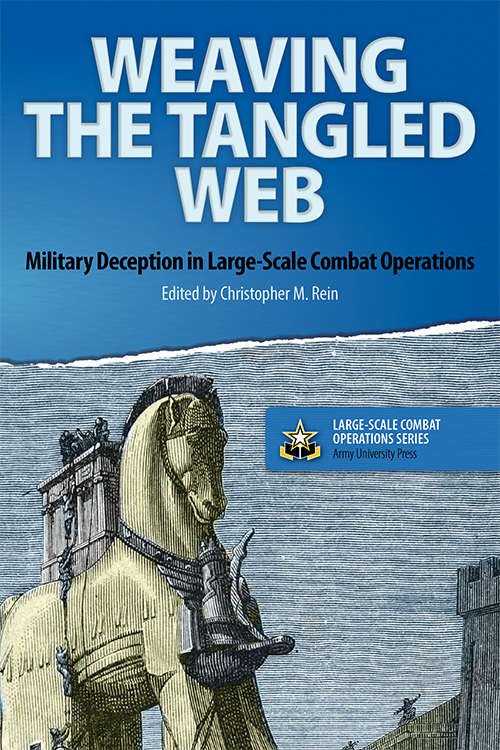
Volume 1
Edited by Christopher M. Rein
Volume 1, Weaving the Tangled Web: Military Deception in Large-Scale Combat Operations surveys twelve cases of MILDEC from World War I through Desert Storm focusing on how armies have successfully used preconceptions to either immobilize an opponent or force the expenditure of energy in unproductive directions. The case studies span the major wars of the twentieth-century from the perspectives of several great powers and offer both a primer for planners of military deception and a caution for all military personnel to remain constantly on guard for practitioners of this ancient art.
Published: September 2018
Historical Case Studies of Combined Arms Maneuver in Large-Scale Combat Operations
Volume 2
Edited by Peter J. Schifferle
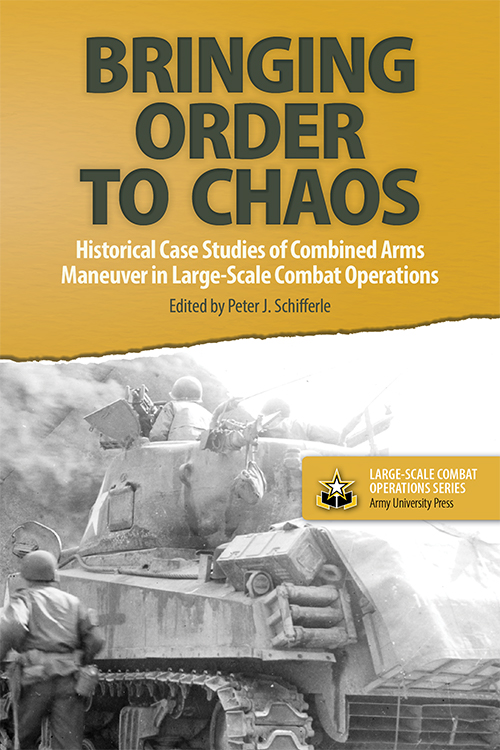
Volume 2, Bringing Order to Chaos: Combined Arms Maneuver in Large Scale Combat Operations, opens a dialogue with the Army. Are we ready for the significantly increased casualties inherent to intensive combat between large formations, the constant paralyzing stress of continual contact with a peer enemy, and the difficult nature of command and control while attempting division and corps combined arms maneuver to destroy that enemy? The chapters in this volume answer these questions for combat operations while spanning military history from 1917 through 2003. These accounts tell the challenges of intense combat, the drain of heavy casualties, the difficulty of commanding and controlling huge formations in contact, the effective use of direct and indirect fires, the need for high quality leadership, thoughtful application of sound doctrine, and logistical sustainment up to the task. No large scale combat engagement, battle, or campaign of the last one hundred years has been successful without being better than the enemy in these critical capabilities. What can we learn from the past to help us make the transition to ready to fight tonight?
Published: September 2018
Historical Case Studies of Converging Cross-Domain Fires in Large-Scale Combat Operations
Volume 3
Edited by Thomas G. Bradbeer
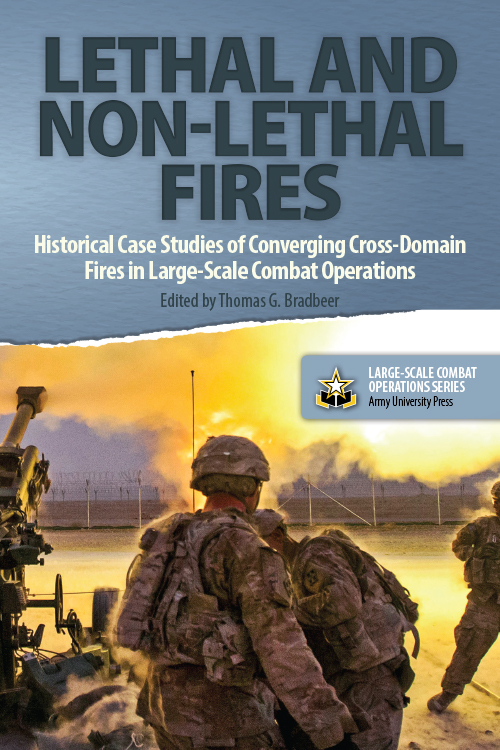 Volume 3, Lethal and Non-Lethal Fires: Historical Case Studies of Converging Cross-Domain Fires in Large Scale Combat Operations, provides a collection of ten historical case studies from World War I through Desert Storm. The case studies detail the use of lethal and non-lethal fires conducted by US, British, Canadian, and Israeli forces against peer or near-peer threats. The case studies span the major wars of the twentieth-century and present the doctrine the various organizations used, together with the challenges the leaders encountered with the doctrine and the operational environment, as well as the leaders’ actions and decisions during the conduct of operations. Most importantly, each chapter highlights the lessons learned from those large scale combat operations, how they were applied or ignored and how they remain relevant today and in the future.
Volume 3, Lethal and Non-Lethal Fires: Historical Case Studies of Converging Cross-Domain Fires in Large Scale Combat Operations, provides a collection of ten historical case studies from World War I through Desert Storm. The case studies detail the use of lethal and non-lethal fires conducted by US, British, Canadian, and Israeli forces against peer or near-peer threats. The case studies span the major wars of the twentieth-century and present the doctrine the various organizations used, together with the challenges the leaders encountered with the doctrine and the operational environment, as well as the leaders’ actions and decisions during the conduct of operations. Most importantly, each chapter highlights the lessons learned from those large scale combat operations, how they were applied or ignored and how they remain relevant today and in the future.Published: September 2018
Historical Case Studies of Sustainment in Large-Scale Combat Operations
Volume 4
Edited by Keith R. Beurskens
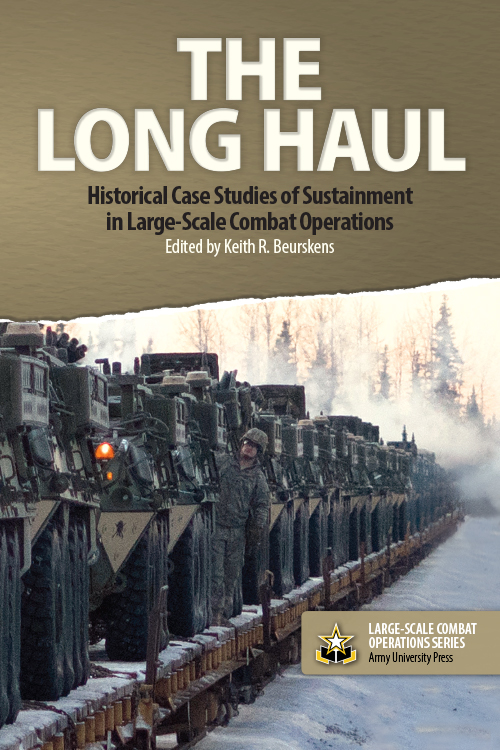 Volume 4, The Long Haul: Sustainment Operations in Large-Scale Combat Operations is a collection of eleven historical case studies of sustainment operations drawn from the past one hundred years with lessons for modern LSCO. The book is organized chronologically, specifically including World Wars I and II, the Korean War, the Vietnam War, the Falklands War, Operation Desert Storm, and Operation Iraqi Freedom. The commanding general for the Combined Armed Support Command (CASCOM) presents future sustainment trends to conclude the book.
Volume 4, The Long Haul: Sustainment Operations in Large-Scale Combat Operations is a collection of eleven historical case studies of sustainment operations drawn from the past one hundred years with lessons for modern LSCO. The book is organized chronologically, specifically including World Wars I and II, the Korean War, the Vietnam War, the Falklands War, Operation Desert Storm, and Operation Iraqi Freedom. The commanding general for the Combined Armed Support Command (CASCOM) presents future sustainment trends to conclude the book.Published: September 2018
Historical Case Studies of Maneuver in Large-Scale Combat Operations
Volume 5
Edited by Jack D. Kem

Volume 5, Deep Maneuver: Historical Case Studies of Maneuver in Large-Scale Combat Operations, presents eleven case studies from World War II through Operation Iraqi Freedom focusing on deep maneuver in terms of time, space and purpose. Deep operations require boldness and audacity, and yet carry an element of risk of overextension – especially in light of the independent factors of geography and weather that are ever-present. As a result, the case studies address not only successes, but also failure and shortfalls that result when conducting deep operations. The final two chapters address these considerations for future Deep Maneuver.
Published: September 2018
Historical Case Studies of Mobility Operations in Large-Scale Combat Operations
Volume 6
Edited by Florian L. Waitl
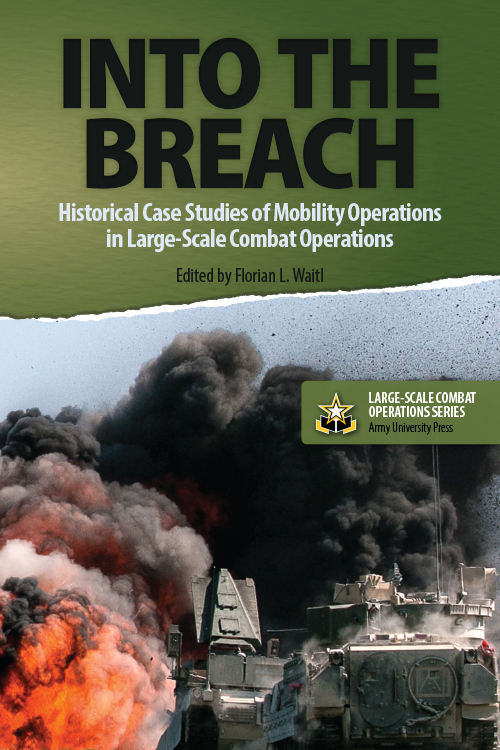
Volume 6, Into the Breach: Historical Case Studies of Mobility Operations in Large-Scale Combat Operations, examines ten historical case studies of mobility and countermobility operations from World War I through Desert Storm. The case studies take a closer look at mobility and countermobility successes and failures in large-scale combat operations against peer or near-peer threats. The chapters highlight several insights, themes, and patterns that current commanders and doctrine developers must be aware of when discussing or conducting mobility operations. The final chapter addresses future mobility and countermobility developments that the U.S. Army will face in Multi-Domain Operations (MDO) against peer and near-peer adversaries.
Published: September 2018
Historical Case Studies of Information Operations in Large-Scale Combat Operations
Volume 7
Edited by Colonel Mark D. Vertuli and Lieutenant Colonel Bradley S. Loudon
 Volume 7, Perceptions Are Reality: Historical Case Studies of Information Operations in Large-Scale Combat Operations, is a collection of ten historical case studies from World War II through the recent conflicts in Afghanistan and Ukraine. The eleventh and final chapter looks forward and explores the implications of the future information environment across the range of military operations during both competition and conflict. The case studies illustrate how militaries and subnational elements use information to gain a position of relative advantage during large-scale combat. The intent of this volume is to employ history to stimulate discussion and analysis of the implications of information operations in future LSCO by exploring past actions, recognizing and understanding successes and failures, and offering some lessons learned from each author’s perspective.
Volume 7, Perceptions Are Reality: Historical Case Studies of Information Operations in Large-Scale Combat Operations, is a collection of ten historical case studies from World War II through the recent conflicts in Afghanistan and Ukraine. The eleventh and final chapter looks forward and explores the implications of the future information environment across the range of military operations during both competition and conflict. The case studies illustrate how militaries and subnational elements use information to gain a position of relative advantage during large-scale combat. The intent of this volume is to employ history to stimulate discussion and analysis of the implications of information operations in future LSCO by exploring past actions, recognizing and understanding successes and failures, and offering some lessons learned from each author’s perspective.Published: September 2018
Special Operations Forces in Large-Scale Combat Operations
Volume 8
Edited by Robert M. Toguchi and Michael E. Krivdo

Volume 8, The Competitive Advantage: Special Operations Forces in Large Scale Combat Operations presents twelve historical case studies of special operations forces from World War I through Operation Iraqi Freedom. This volume sheds light upon the emerging roles, missions, and unique capabilities that have forged a path for Army Special Operations Forces today. These case studies set Large Scale Combat Operations in the center and place ARSOF’s role in the forefront. If a reader were to take one piece from this volume, it would be the clear understanding of the close synergy that occurs between the Conventional Force and SOF in Large Scale Combat Operations for major wars in the 20th and early 21st century. That synergy should provide a broad azimuth for military planners and practitioners to follow as the Army, SOF, and the Joint Force combine to preserve the peace, defend the Nation, and defeat any adversary.
Published: May 2019
The Crucible of Close Combat in Large-Scale Combat Operations
Volume 9
Edited by Col. Paul E. Berg, U.S. Army
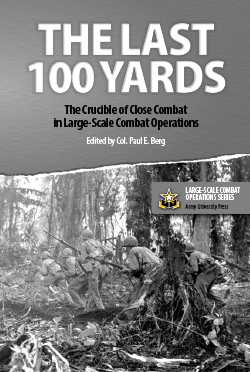 Volume 9, The Last 100 Yards: The Crucible of Close Combat in Large-Scale Combat Operations presents thirteen historical case studies of close combat operations from World War I through Operation Iraqi Freedom. This volume is a collection from the unique and deliberate perspective of the last 100 yards of ground combat. In today’s Army, there are few leaders who have experienced multi-domain large-scale ground combat against a near-peer or peer enemy first hand. This volume serves to augment military professionals’ understanding of the realities of large-scale ground combat operations through the experiences of those who lived it.
Volume 9, The Last 100 Yards: The Crucible of Close Combat in Large-Scale Combat Operations presents thirteen historical case studies of close combat operations from World War I through Operation Iraqi Freedom. This volume is a collection from the unique and deliberate perspective of the last 100 yards of ground combat. In today’s Army, there are few leaders who have experienced multi-domain large-scale ground combat against a near-peer or peer enemy first hand. This volume serves to augment military professionals’ understanding of the realities of large-scale ground combat operations through the experiences of those who lived it.Published: June 2019
The Profession and Ethic in Large-Scale Combat Operations
Volume 10
Edited by C. Anthony Pfaff and Keith R. Beurskens
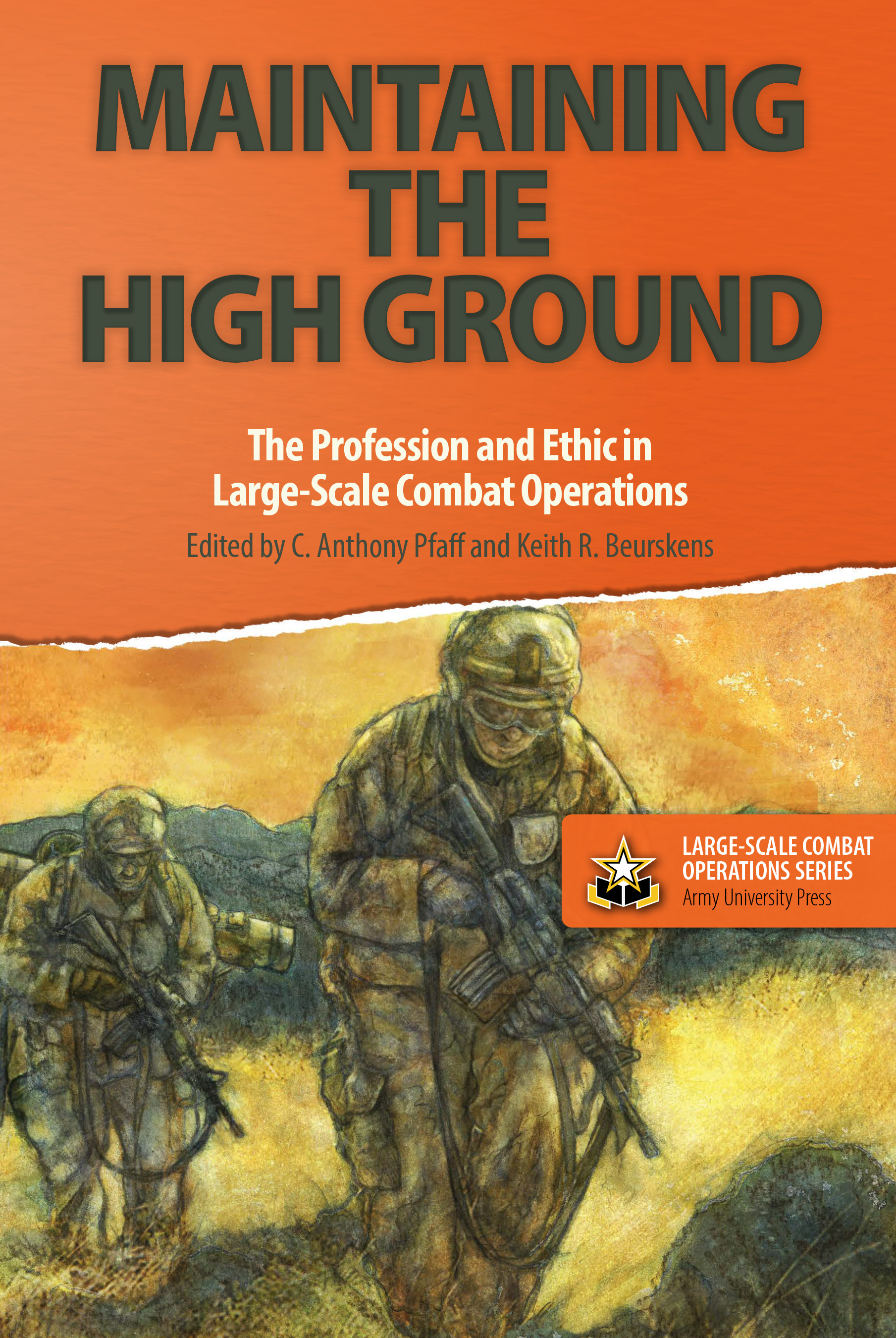
Volume 10, Maintaining the High Ground: The Profession and Ethic in Large-Scale Combat Operations combines discussions and historical case studies from the past seventy-five years to address ethical challenges for the Army Profession. Healthy and functioning professions facilitate the employment of expert knowledge to serve a social good. In doing so, trust develops among professionals, as well as with the client, creating an acknowledged autonomy over its jurisdiction that allows the profession to maintain its effectiveness. For the Army, that jurisdiction is the application of land power and its client is the US government and the American public it serves. With today’s all-volunteer Army, maintaining public trust is critical, and large-scale combat operations require a professional class of leaders and soldiers with strong ethics and the ability to adapt and even shape their own future.
Published: June 2021
No comments:
Post a Comment